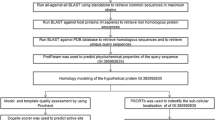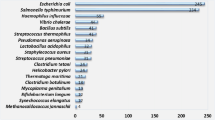Abstract
Background
Among the resistant isolates of MTB, multidrug resistant tuberculosis (MDR-TB) and extensively drug resistant tuberculosis (XDR-TB) have been the areas of growing concern. The genomic analysis showed that the respective genomic pool of the XDR-MTB proteome contains more than 30% of the hypothetical proteins for which no functions have been annotated yet. This class of proteins presumably have their own importance to complete genome and proteome information. The bioinformatics advancements have helped to annotate those hypothetical proteins by using various computational tools and have potential to classify them functionally.
Objective
The objective of this study was to propose a new and unique drug target against the deadly Mycobacterium tuberculosis using Bioinformatics approaches to characterize the hypothetical proteins.
Results
We stepwise reduced the hypothetical proteins (total number: 1256) out of the complete proteome to only 26 essential hypothetical proteins. Out of those 26 proteins, the protein WP_003401246.1 was computationally characterized as the druggable target.
Conclusion
The study proposed a hypothetical protein from complete proteome of the XDR-MTB as a new drug target against which new drug candidates can be proposed. Hence, the study opens up the new avenues in the areas of drug discovery against deadly M. tuberculosis.








Similar content being viewed by others
References
Altschul SF, Gish W, Miller W, Myers EW, Lipman DJ (1990) Basic local alignment search tool. J Mol Biol 215:403–410
Ardiccioni C, Clarke OB, Tomasek D, Issa HA, Desiree C, Pond HL, Banerjee S, Rajashankar KR, Liu Q, Guan Z (2016) Structure of the polyisoprenyl-phosphate glycosyltransferase GtrB and insights into the mechanism of catalysis. Nat Commun 7:10175
Armon A, Graur D, Ben-Tal N (2001) ConSurf: an algorithmic tool for the identification of functional regions in proteins by surface mapping of phylogenetic information. J Mol Biol 307:447–463
Bourne Y, Henrissat B (2001) Glycoside hydrolases and glycosyltransferases: families and functional modules. Curr Opin Struct Biol 11:593–600
Campbell JA, Davies GJ, Bulone V, Henrissat B (1997) A classification of nucleotide-diphospho-sugar glycosyltransferases based on amino acid sequence similarities. Biochem J 326(Pt 3):929–939
CLC Sequence Viewer (2011) (https://www.qiagenbioinformatics.com/). Accessed 2 Jun
Coutinho PM, Deleury E, Davies GJ, Henrissat B (2003) An evolving hierarchical family classification for glycosyltransferases. J Mol Biol 328:307–317
Doerks T, van Noort V, Minguez P, Bork P (2012) Annotation of the M. tuberculosis hypothetical orfeome: adding functional information to more than half of the uncharacterized proteins. PLoS One 7:e34302
Fiser A, Sali A (2003) Modeller: generation and refinement of homology-based protein structure models. Methods Enzymol 374:461–491
Geourjon C, Deleage G (1995) SOPMA: significant improvements in protein secondary structure prediction by consensus prediction from multiple alignments. Bioinformatics 11:681–684
Gupta A, Singh A, Singh S (2014) Glycogenomics of Mycobacterium tuberculosis. Mycobact Dis 4(2161–1068):1000175
Hatherley R, Brown DK, Glenister M, Tastan Bishop O (2016) PRIMO: an interactive homology modeling pipeline. PLoS One 11:e0166698
Illergard K, Ardell DH, Elofsson A (2009) Structure is three to ten times more conserved than sequence–a study of structural response in protein cores. Proteins 77:499–508
Jones P, Binns D, Chang HY, Fraser M, Li W, McAnulla C, McWilliam H, Maslen J, Mitchell A, Nuka G et al (2014) InterProScan 5: genome-scale protein function classification. Bioinformatics 30:1236–1240
Laskowski RA, MacArthur MW, Moss DS, Thornton JM (1993) PROCHECK: a program to check the stereochemical quality of protein structures. J Appl Crystallogr 26:283–291
Lombard V, Golaconda Ramulu H, Drula E, Coutinho PM, Henrissat B (2014) The carbohydrate-active enzymes database (CAZy) in 2013. Nucleic Acids Res 42:D490–D495
McGuffin LJ, Bryson K, Jones DT (2000) The PSIPRED protein structure prediction server. Bioinformatics 16:404–405
Mitchell AL, Attwood TK, Babbitt PC, Blum M, Bork P, Bridge A, Brown SD, Chang H-Y, El-Gebali S, Fraser MI (2018) InterPro in 2019: improving coverage, classification and access to protein sequence annotations. Nucleic Acids Res 47:D351–D360
Morris GM, Huey R, Lindstrom W, Sanner MF, Belew RK, Goodsell DS, Olson AJ (2009) AutoDock4 and AutoDockTools4: automated docking with selective receptor flexibility. J Comput Chem 30:2785–2791
Pagni M, Ioannidis V, Cerutti L, Zahn-Zabal M, Jongeneel CV, Falquet L (2004) MyHits: a new interactive resource for protein annotation and domain identification. Nucleic Acids Res 32:W332–W335
Pham TT, Stinson B, Thiyagarajan N, Lizotte-Waniewski M, Brew K, Acharya KR (2014) Structures of complexes of a metal-independent glycosyltransferase GT6 from Bacteroides ovatus with UDP-N-acetylgalactosamine (UDP-GalNAc) and its hydrolysis products. J Biol Chem 289:8041–8050
Schwede T (2013) Protein modeling: what happened to the “protein structure gap”? Structure 21:1531–1540
Shahbaaz M, Bisetty K, Ahmad F, Hassan MI (2015) Towards new drug targets? Function prediction of putative proteins of neisseria meningitidis MC58 and their virulence characterization. OMICS 19:416–434
Taghizade Moghaddam H, Emami Moghadam Z, Khademi G, Bahreini A, Saeidi M (2016) Tuberculosis: past, present and future. Int J Pediatr 4:1243–1254
Uddin R, Siddiqui QN, Azam SS, Saima B, Wadood A (2018) Identification and characterization of potential druggable targets among hypothetical proteins of extensively drug resistant Mycobacterium tuberculosis (XDR KZN 605) through subtractive genomics approach. Eur J Pharm Sci 114:13–23
Vetting MW, Frantom PA, Blanchard JS (2008) Structural and enzymatic analysis of MshA from Corynebacterium glutamicum: substrate-assisted catalysis. J Biol Chem 283:15834–15844
Wass MN, Sternberg MJ (2009) Prediction of ligand binding sites using homologous structures and conservation at CASP8. Proteins 77(Suppl 9):147–151
Webb B, Sali A (2014) Comparative protein structure modeling using MODELLER. Curr Protoc Bioinf 47:5.6.1–5.6.32
Willard L, Ranjan A, Zhang H, Monzavi H, Boyko RF, Sykes BD, Wishart DS (2003) VADAR: a web server for quantitative evaluation of protein structure quality. Nucleic Acids Res 31:3316–3319
Woo EJ, Ryu SI, Song HN, Jung TY, Yeon SM, Lee HA, Park BC, Park KH, Lee SB (2010) Structural insights on the new mechanism of trehalose synthesis by trehalose synthase TreT from Pyrococcus horikoshii. J Mol Biol 404:247–259
Zhang R, Ou HY, Zhang CT (2004) DEG: a database of essential genes. Nucleic Acids Res 32:D271–D272
Acknowledgements
The authors would like to gratefully acknowledge the Higher Education Commission of Pakistan for providing the financial support (Grant # 20-3420/NRPU/R&D/HEC/14/1093) for this study.
Author information
Authors and Affiliations
Corresponding author
Ethics declarations
Conflict of interest
Reaz Uddin, Quratulain Nehal Siddiqui, Muhammad Sufian, Syed Sikander Azam and Abdul Wadood declare that they have no conflict of interest.
Additional information
Publisher's Note
Springer Nature remains neutral with regard to jurisdictional claims in published maps and institutional affiliations.
Electronic supplementary material
Below is the link to the electronic supplementary material.
13258_2019_857_MOESM1_ESM.pdf
All the computational commands and scripts used in this study are provided as github repository here: https://github.com/mriazuddin/HypotheticalProteins Supplementary File S1: The multiple sequence alignment from CLC Sequence viewer (PDF 1957 kb)
Rights and permissions
About this article
Cite this article
Uddin, R., Siddiqui, Q.N., Sufian, M. et al. Proteome-wide subtractive approach to prioritize a hypothetical protein of XDR-Mycobacterium tuberculosis as potential drug target. Genes Genom 41, 1281–1292 (2019). https://doi.org/10.1007/s13258-019-00857-z
Received:
Accepted:
Published:
Issue Date:
DOI: https://doi.org/10.1007/s13258-019-00857-z




